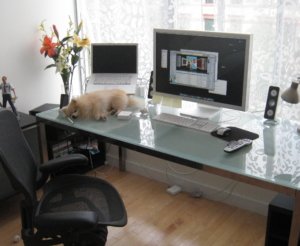On a coaching call from my back deck “desk”, I encouraged my client to step away from the screen and take a walk during our session. Far from “phoning it in”, the movement got his wheels turning, the sun shone on some new insights, and overall the work-from-home flexibility helped us do some exceptional work together.
Access a touch of outdoor inspiration and exercise for an extra boost of critical thinking and creativity. These days, we have the built-in excuse to be out of the traditional office (government mandated WFH for most), and it’s Spring, so we can just open the front door to get moving.
But this isn’t only about making the most of being at home. Science that backs up the reasons the “walk-and-talk” should have always been, and should continue to be, more the rule than the exception.
As reported in a compelling German research paper, “moderate physical activity improves various cognitive functions, particularly when it is applied simultaneously to the cognitive task.” In other words, moving and thinking is a great combo. Various studies show that from new info recall, to generating ideas, to focused thinking, the benefits of the walking meeting are many.
Even better if you can find your way among greenery. Shinrin-yoku, the Japanese art called “forest bathing” in English, involves slow, meditative exploration of natural areas with all your senses. Literally just being in the forest can have immediate positive physiological effects. If you don’t have the trees or the time for this brand of eco-therapy, the good news is that positive health effects are found in a wide spectrum of exposure to foliage. In the book Your Brain on Nature , among dozens of studies that support nature=good for you, they reference Dr. Roger Ulrich’s research that patients with plants in their hospital rooms required less pain medication, had lower blood pressure and heart rates, higher energy, and more positive thoughts.
Leaders, you’re saying, “Yes! Exercise! Self-care! Get outside! Ergonomic set up! Spinach for lunch! I have a FitBit!” Of course, we all know what we should do. I was coaching someone today who’s promoting and preaching all the right things for health of his team, meanwhile admitting to me that he gets 2500 steps a day according to his tracking device (research says 10,000 steps a day is a healthy minimum goal). Working from his cottage (points for nature), he’s blocked the window that creates a reflection on his screen so he can hole himself up and tackle the eight straight hours of video calls each day (eek!)
With a friendly nudge, this well-meaning individual agreed to admit these habits to his team, in the hope the honesty inspires solutions that transform the shoulds into some compelling, functional and sustainable healthy practices they can pursue together. In a quick brainstorm, he and I came up with just a few to get the ball rolling for when he tables it at his next meeting:
- Finish all meetings at a quarter-to the hour to allow at least a 15 minute break when you’re back-to-back
- Earmark your former commute time to “commute” somewhere on foot, outside. Take a picture of some nature on route and share it!
- Position yourself so you can see greenery from your workspace. Or add a plant to the home office.
- Change video calls to phone calls if appropriate, so you can stretch or walk while chatting. (Another client of mine unapologetically bikes while on conference calls.)
- Share what’s working and what’s not, so you can learn from co-workers.
- Request a weekly tip or challenge from the group, and take it on together, to create some focus and accountability.
In this time of change, we all need to find our groove with new routines. Take it easy on yourself, and embrace trial-and-error as a part of the process. But don’t give up! Let go of the guilt of creeping scale numbers or the pressure of being perfect. Instead, just do your best to model with enthusiasm the process of building good habits in a new work environment.






